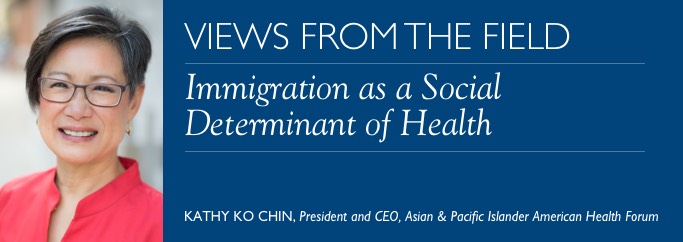
As an immigrants’ rights advocate working on health policy, I and my organization, the Asian & Pacific Islander American Health Forum (APIAHF), are constantly faced with the concept that people of color are perpetual foreigners, not “real” Americans. This is despite the five generations of Chinese Americans and countless other immigrants who have been contributing to this country for centuries.
The bedrock of our immigration policy is exclusion. The Chinese Exclusion Act of 1882 was the first-ever federal legislation to ban an entire population solely on the basis of race or national origin and was not repealed until the 1940s. Anti-immigrant sentiment continues to run through our laws, from the rise of anti-immigrant policies of the 1990s to the overwhelmingly anti-immigrant rhetoric permeating our society today.
For the two-thirds of Asian Americans and Pacific Islanders (AAPIs) who are immigrants, their status determines almost every facet of daily life. There are many different immigration statuses: young DREAMers, documented and undocumented, green card holders, and those who live in the United States under a special agreement known as the Compact of Free Association (COFA).
For many immigrants, federal law serves as the gatekeeper to their health, with policies blocking coverage options that they financially support through taxes. Prior to 1996, immigrants of various statuses were included in public programs like Medicaid. The “welfare reform” of 1996 came with a cost: the arbitrary classifications of “qualified” or “non-qualified” status. Now, immigrants must wait five years to become “qualified” before they are eligible for Medicaid or the Children’s Health Insurance Program (CHIP).
State-based eligibility for lawfully present immigrant children and pregnant women became law in 2007 through the Legal Immigrant Children’s Health Improvement Act (ICHIA). Under ICHIA, 22 states opted to provide Medicaid and CHIP coverage during the “five-year ban.” In 2009, CHIP reauthorization included ICHIA and the number of states extending coverage increased to 33 (Schwartz 2016).
The Affordable Care Act (ACA) significantly expanded coverage by making all “lawfully present” immigrants eligible for tax credits and/or cost-sharing subsidy. However, the ACA completely restricts undocumented immigrants from the Marketplace. The Obama Administration also removed eligibility for Deferred Action for Childhood Arrivals (DACA) recipients, undermining their precarious legal status—long before the Trump Administration proposed to eliminate the program altogether.
One thing is clear: our system is exclusionary and leaves millions without the resources, help, or care they need, based on their immigration status. Yet, the future is not entirely bleak, as expanded coverage under the ACA and continued adoption of ICHIA in states like Utah and Arizona show small, but significant steps toward health equity for immigrants.
If we intend to create a truly equitable society, immigration status should not be a social determinant of health. Funders can support proactive strategies to improve care by supporting research on immigrant health needs, reshaping the narrative of who deserves health care, and directly influencing decisionmakers on the allocation of health resources. To do this, they will need to pay close attention to demographics and data, and help to ensure immigrants’ access to health coverage and care.
Demographics
The health care needs of immigrants are influenced by country of origin and specific cultures. Asian Americans, Native Hawaiians and Pacific Islanders speak more than 100 different languages and trace their heritage to more than 50 different countries and ethnic groups. Fifty years from now, immigrants from Asian countries will make up the largest percentage of foreign-born in the U.S. for the first time, though Latinos will continue make up a significant portion (U.S. Census Bureau). Where immigrants live is also changing, with immigrants moving beyond expected metro areas into, for example, Atlanta, Las Vegas and Detroit.
Data
Identifying the health care needs of immigrant communities requires better data, not just at a national level, but disaggregated by race and ethnic groups and by geographic level. For example, aggregated as one single group before the 2013 ACA expansion, AAPIs had the highest rates of coverage and the lowest rates of uninsurance. But disaggregated data revealed that Korean Americans had the highest rates of uninsurance (24 percent) in the country, followed by Bangladeshis and Pakistanis (each 23 percent) (APIAHF, 2016). In order to reveal disparities and address health equity, we need data to point the way.
The upcoming 2020 Census provides a pivotal opportunity to collect data that informs federal policies, regulations, funding, and Congressional districts. Unfortunately, current data collection is not adequately disaggregated to see community disparities like the above example. Furthermore, proposed questions about immigration status coupled with the current climate will undermine an accurate count, as many immigrants will fear participating.
Access to Coverage and Care
By building the evidence on immigrant health needs, we can advance improvements to immigrant coverage and care. On local, state, and national levels, we need to understand the impact of the new anti-immigrant policies on health care utilization, such as immunization rates, mental health, participation in public nutrition assistance and health insurance, as well as attitudes about health care and well-being. Access for one population should not be pitted against access for another; it is critical to provide health care access to all, including immigrants of any immigration status.
I truly believe that data, evidence, and stories that demonstrate the effects of our everyday realities will drive policy change. Immigrants shape the fabric of our country, and philanthropy’s resources are needed to support the analysis and compilation of this evidence into a compelling and succinct case that helps all of us to move beyond our current policies and strive for improvement in immigrant health and health care.
References
Schwartz, Sonya. ICHIA Option: Which States Cover Legal Immigrant Children in Medicaid/CHIP? Georgetown University, March 24, 2016.
U.S. Census Bureau. “American Community Survey.” September 1, 2016.
APIAHF analysis 2016 American Community Survey 1-year estimates, Table S0201.

